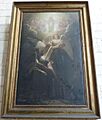Colette of Corbie facts for kids
Quick facts for kids SaintColette of Corbie PCC |
|
|---|---|

Saint Colette (detail of Saint Clare and Saint Colette, c. 1520, by the Master of Lourinhã; National Museum of Ancient Art, Portugal)
|
|
| Virgin | |
| Born | Nicole Boellet 13 January 1381 Corbie, County of Amiens, Duchy of Burgundy |
| Died | 6 March 1447 (aged 66) Ghent, County of Flanders, Duchy of Burgundy |
| Venerated in | Roman Catholicism |
| Beatified | 23 January 1740 by Pope Clement XII |
| Canonized | 24 May 1807 by Pope Pius VII |
| Feast | 6 March |
Colette of Corbie (born 13 January 1381, died 6 March 1447) was a French nun who became a saint. She was an abbess, which is like the leader of a group of nuns. Colette started a new, stricter branch of the Poor Clares, a well-known group of nuns. This new group is called the Colettine Poor Clares.
Many people believe Colette performed miracles during her life. Because of this, she is seen as a special helper, or patron saint, for women hoping to have children, for pregnant mothers, and for sick children.
Contents
Colette's Life Story
Her Early Years
Colette was born as Nicole Boellet in a village called Corbie in France. Her parents, Robert and Marguerite, were older and had no children. They prayed to Saint Nicholas for a child. When Marguerite was 60, she gave birth to Nicole. They named her after Saint Nicholas out of thanks. Her family lovingly called her Nicolette, which later became Colette.
After her parents passed away in 1399, Colette tried living with the Beguines, a group of religious women. But she felt it wasn't challenging enough for her. She then joined a Benedictine group as a lay sister, possibly to avoid an arranged marriage. Still, she wasn't happy with this life either.
In 1402, Colette decided to live as a hermit near the abbey church. She wore the special clothes of the Third Order of St. Francis. For four years, she lived a very simple and strict life. During this time, she had dreams and visions. She began to believe that God was calling her to make changes to the Poor Clares order. She felt they needed to return to their original, very simple way of life, focusing on being truly poor.
Starting a New Order
In 1406, Colette went to meet Antipope Benedict XIII in Nice, France. At that time, there were two popes, and Benedict was the one recognized in France. He allowed Colette to join the Order of Poor Clares. He also gave her permission, through special letters called papal bulls, to start new monasteries and to bring back the original strict rules to the order.
With help from the Countess of Geneva and a Franciscan preacher named Henry de Beaume, Colette began her work. Her first monastery opened in 1410 in Besançon, France. It was in a nearly empty house of Poor Clares. From there, her new way of life spread. She founded monasteries in places like Auxonne (1412), Poligny (1415), Ghent (1412), and Heidelberg (1444).
During her lifetime, Colette helped start 18 monasteries that followed her reforms. For these monasteries, she set very strict rules. Nuns had to live in extreme poverty, go barefoot, and always fast and avoid certain foods.
The special rules for Colette's monasteries, called Constitutions, were approved by church leaders several times. They were approved by Pope Nicholas V in 1448 and Pope Pius II in 1458.
Colette passed away in Ghent in March 1447.
Becoming a Saint
Colette was recognized as a blessed person (beatified) on 23 January 1740 by Pope Clement XII. She was later declared a saint (canonized) on 24 May 1807 by Pope Pius VII. People pray to her if they want to have children. She is also seen as a special helper for pregnant mothers and sick babies.
Colette's Lasting Impact
Colettine Nuns Today
Today, you can find Colettine nuns in many countries. These include France, Ireland, Italy, the United Kingdom, and the United States. They continue to follow the strict rules and simple way of life that Saint Colette started.
Colettine Friars
Colette also helped start a reform among the Franciscan friars, who were male religious. These friars were known as the Coletans. They followed Henry of Beaume's leadership but remained part of the larger Franciscan order. They didn't become a very large group. By 1448, they had only thirteen friaries, all connected to Colettine nun monasteries. Later, in 1517, these friars joined a bigger branch of the Franciscan order.
Amazing Stories and Miracles
People who wrote about Colette's life say she performed many miracles. These included making food or wine multiply and healing sick people, sometimes even after her death.
Helping a Mother Give Birth
Once, while Colette was traveling, she stayed at a friend's house. His wife was having a very difficult time giving birth to their third child and was in danger. Colette immediately went to the local church to pray for her.
The mother successfully gave birth and survived. She believed Colette's prayers had saved her. The baby girl born that day, named Petronilla, later became a nun in one of Colette's monasteries. She even became Colette's secretary and wrote about her life.
Saving a Sick Child
When Colette began her strict reforms at the Poor Clare monastery in Besançon, some local people were unsure about it. They worried about supporting the monastery, which relied completely on donations. One event helped change their minds.
On another occasion, Colette brought a stillborn child back to life. She took off the special veil given to her by the Pope and wrapped the child's body in it.
Pictures
See also
 In Spanish: Coleta Boylet de Corbie para niños
In Spanish: Coleta Boylet de Corbie para niños
- Colettine Poor Clares




